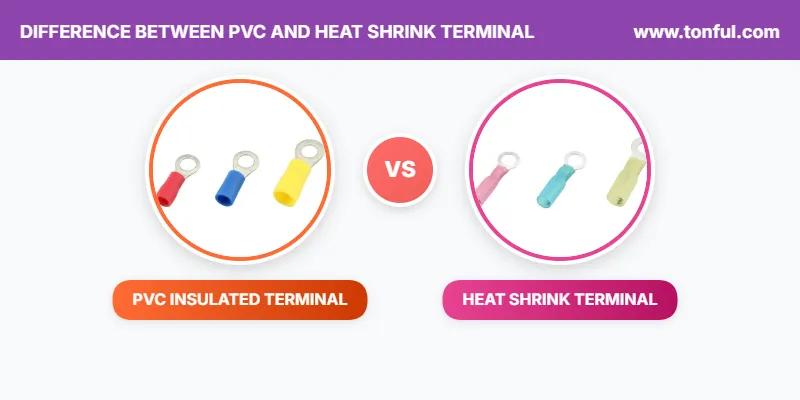Choosing the right electrical terminals can make the difference between a connection that lasts decades and one that fails within months. If you’re deciding between PVC insulated and heat shrink terminals, you’re not alone—this choice impacts everything from cost to reliability in your electrical projects.
This comprehensive comparison will help you understand when to use each type of terminal, what they cost long-term, and how to install them properly for maximum performance.
Quick Answer: When to Use Each Type
Choose PVC Insulated Terminals for:
- Indoor electrical work where moisture isn’t a concern
- Budget-conscious projects requiring basic protection
- Quick installations in protected environments
- Standard automotive interior applications
Choose Heat Shrink Terminals for:
- Marine electrical systems exposed to moisture
- Automotive engine bay connections
- Outdoor installations facing weather exposure
- Industrial applications requiring maximum reliability
Understanding the Basic Differences
PVC Insulated Terminals
PVC (polyvinyl chloride) insulated terminals are the most common electrical connectors you’ll find in hardware stores. They feature a colored plastic sleeve—typically red, blue, or yellow—that provides basic protection around the metal terminal.
Key characteristics:
- Cost-effective solution for general electrical work
- Simple crimp installation with standard tools
- Available everywhere in common sizes
- Operating temperature range: -40°C to +105°C
- No waterproof sealing capability
Heat Shrink Terminals
Heat shrink terminals represent premium electrical connection technology. They feature dual-wall construction with a heat-activated adhesive that creates a waterproof seal when heated.
Key characteristics:
- Premium protection for harsh environments
- Require heat gun for proper installation
- Epoxy-lined for complete environmental sealing
- Operating temperature range: -40°C to +125°C
- Waterproof and corrosion-resistant when properly installed
Head-to-Head Performance Comparison
Cost Analysis
Initial Purchase Price:
- PVC terminals: $0.10 – $0.30 per piece
- Heat shrink terminals: $0.25 – $0.75 per piece
Installation Time:
- PVC terminals: 30-60 seconds per connection
- Heat shrink terminals: 2-3 minutes per connection
Long-term Value:
While heat shrink terminals cost 2-3 times more initially, they often provide better value in demanding applications. A marine electrical system using heat shrink connections might last 10-15 years without maintenance, while PVC terminals in the same environment could need replacement every 2-3 years.
Environmental Protection
| Factor | PVC Insulated | Heat Shrink |
|---|---|---|
| Waterproofing | ❌ None | ✅ Complete seal |
| Corrosion resistance | ⚠️ Basic | ✅ Excellent |
| Vibration protection | ⚠️ Limited | ✅ Superior strain relief |
| Chemical resistance | ⚠️ Moderate | ✅ High |
| UV resistance | ⚠️ Limited | ✅ Excellent |
Installation Requirements
PVC Terminal Installation:
- Standard crimping tool
- Wire strippers
- Basic electrical knowledge
- No additional heating equipment needed
Heat Shrink Terminal Installation:
- Quality crimping tool
- Heat gun (400-600°F capability)
- Wire strippers
- Understanding of proper heating techniques
- More time per connection
Application-Specific Recommendations
Marine Electrical Systems
Winner: Heat Shrink Terminals
Marine environments are extremely harsh on electrical connections. Saltwater, humidity, and constant vibration create the perfect storm for electrical failures.
Why heat shrink wins:
- Complete waterproof seal prevents corrosion
- Salt spray cannot penetrate properly installed connections
- Vibration resistance prevents wire fatigue
- Professional marine electricians use heat shrink as standard practice
Cost justification: A typical boat electrical system replacement costs $2,000-$5,000. Using heat shrink terminals adds maybe $200 to the initial cost but can prevent complete system failure.
Automotive Applications
Engine Bay: Heat Shrink Terminals
- Temperature extremes (-40°F to 200°F+)
- Chemical exposure from road salt and fluids
- High vibration environment
- Moisture from weather and washing
Interior: Either Type Works
- Protected environment
- Lower temperatures
- Minimal moisture exposure
- PVC terminals save money without sacrificing performance
Home Electrical Projects
Winner: PVC Insulated Terminals
For indoor home electrical work, PVC terminals provide excellent performance at the lowest cost.
Why PVC works well:
- Protected from weather and moisture
- Lower cost matters for large projects
- Simple installation for DIY work
- Readily available at local stores
Exception: Use heat shrink for outdoor applications like landscape lighting or exterior outlets.
Industrial Applications
Critical Equipment: Heat Shrink Terminals
- Maximum reliability prevents costly downtime
- Harsh environments with chemicals or washdowns
- Professional installation standards
General Equipment: PVC Terminals
- Indoor control panels
- Protected electrical enclosures
- Cost-sensitive applications
Installation Best Practices
Installing PVC Terminals
- Strip the wire to match the terminal barrel length exactly
- Insert the wire fully into the terminal barrel
- Crimp firmly using the correct die size for your terminal
- Test the connection with a gentle tug to ensure it’s secure
- Inspect the crimp to verify proper compression
Common mistakes to avoid:
- Using wrong-size terminals for your wire gauge
- Under-crimping (loose connection)
- Over-crimping (damaged conductors)
- Leaving exposed conductor outside the terminal
Installing Heat Shrink Terminals
- Strip the wire according to terminal specifications
- Insert and crimp the terminal using proper technique
- Apply heat evenly using a heat gun at 400-600°F
- Watch for adhesive to appear at both ends of the tubing
- Allow to cool completely before handling
- Inspect the seal for complete shrinkage and adhesive visibility
Pro tips for success:
- Move the heat gun continuously to avoid overheating
- Start heating from the wire end and move toward the terminal
- Use medium heat setting to avoid burning the tubing
- Quality heat guns produce better results than cheap alternatives
Total Cost of Ownership Analysis
15-Year Marine Installation Example
Scenario: 200 electrical connections on a recreational boat
PVC Terminal Option:
- Initial installation: $80 (materials + labor)
- Replacement every 3 years: $80 × 5 = $400
- Total 15-year cost: $480
Heat Shrink Terminal Option:
- Initial installation: $240 (materials + labor)
- Minimal replacements: $50
- Total 15-year cost: $290
Result: Heat shrink terminals save $190 over 15 years while providing superior reliability and fewer failures.
When PVC Makes Financial Sense
Home electrical panel with 50 connections in a dry basement:
- PVC terminals: $25 initial cost, likely no replacements needed
- Heat shrink terminals: $75 initial cost, no additional benefit
- Savings with PVC: $50 with no performance penalty
Professional Recommendations
Marine Electricians Say:
“We exclusively use heat shrink terminals for any connection that might see moisture. The extra cost is nothing compared to the service calls we prevent.”
Automotive Technicians Recommend:
“Engine bay connections get heat shrink, interior work gets PVC. It’s about matching the terminal to the environment.”
Industrial Maintenance Perspective:
“For critical equipment, we spec heat shrink terminals. For general electrical work in controlled environments, PVC terminals save money without compromising safety.”
Making Your Decision
Choose PVC Insulated Terminals When:
- ✅ Budget is a primary concern and you’re working in protected environments
- ✅ Indoor electrical work where moisture exposure is minimal
- ✅ Quick repairs where installation speed matters
- ✅ Non-critical applications where failure won’t cause major problems
- ✅ High-volume installations in appropriate environments
Choose Heat Shrink Terminals When:
- ✅ Reliability is critical and maintenance access is limited
- ✅ Moisture exposure is possible (marine, outdoor, humid environments)
- ✅ Harsh conditions including vibration, chemicals, or temperature extremes
- ✅ Professional installations where reputation and warranty matter
- ✅ Long-term value is more important than initial cost
Common Mistakes to Avoid
PVC Terminal Mistakes:
- Using them in marine or outdoor applications
- Assuming all PVC terminals are created equal
- Skipping proper crimping technique
- Ignoring wire gauge compatibility
Heat Shrink Terminal Mistakes:
- Using inadequate heat guns or flame sources
- Overheating and damaging the terminal
- Not achieving complete adhesive activation
- Using them unnecessarily in protected environments
Final Recommendations
The choice between PVC insulated and heat shrink terminals isn’t about which is “better”—it’s about matching the right technology to your specific application.
For most DIY home electrical work, PVC terminals provide excellent performance at the lowest cost. Save your money for other project priorities.
For marine, automotive exterior, and critical industrial applications, heat shrink terminals justify their higher cost through superior reliability and longevity.
When in doubt, consider the consequences of connection failure. If a failed connection means costly downtime, safety risks, or difficult replacement, choose heat shrink terminals for peace of mind.
Remember that proper installation technique matters more than terminal type for basic reliability. Whether you choose PVC or heat shrink terminals, invest in quality tools and take time to do the job right. A poorly installed heat shrink terminal will fail faster than a properly installed PVC terminal in appropriate applications.
The bottom line: match your terminal choice to your environment, budget, and reliability requirements. Both types have their place in electrical work—success comes from using each where they perform best.

